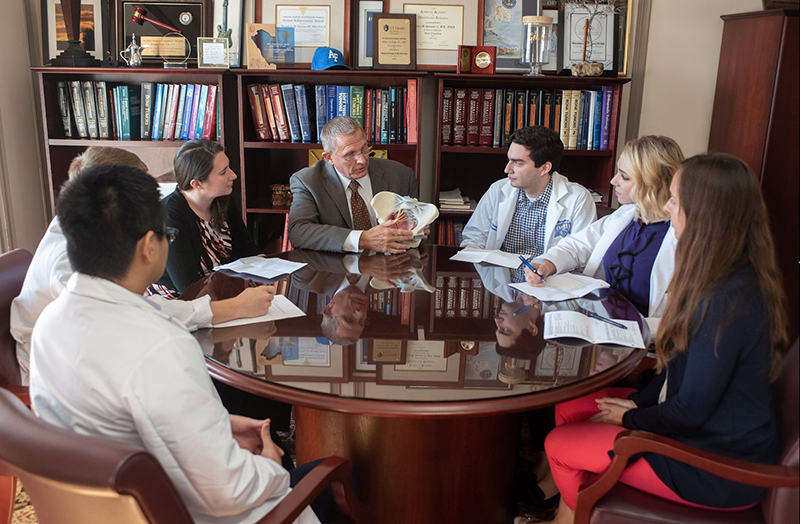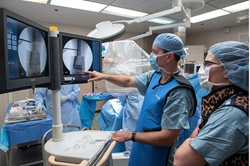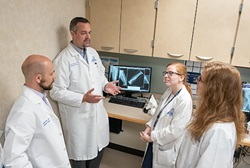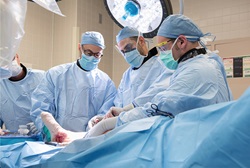Orthopedic Resident Clinical Rotations




PGY-1 Year
The first year affords the residents the opportunity to develop a broad foundation in patient care, orthopaedic knowledge and surgical skills that will be built upon throughout residency. This begins with a 4-week long surgical skills curriculum which consists of hands-on labs as well as time in the clinic and the operating room.
Six rotations are spent on orthopaedic surgery gaining a broad exposure to orthopaedics while creating a solid foundation to build upon throughout the rest of residency. There are two night float rotations on the orthopaedic trauma service, one rotation each on adult reconstruction, spine, sports, and hand and upper extremity. While on these rotations, there is significant operative time in addition to time spent seeing patients in the clinic, evaluating them in the emergency room, and managing them on the floor.
Six rotations are spent outside of the orthopaedic surgery department, two in the surgical intensive care unit, two on plastic surgery, one on vascular surgery, and one on musculoskeletal radiology.
PGY-2 and PGY-3 Years
The goal of the junior rotations is to provide exposure to and foundational knowledge in all of the orthopaedic subspecialties. As juniors, residents gain autonomy while advancing their surgical skills. The cornerstone of these years are the “Trauma Junior” rotations where residents take call at our busy Level 1 trauma center learning how to manage high acuity patients with complex injuries from the emergency room to the operating room. The trauma junior always has the trauma intern on night float with them to assist as needed and to allow the junior to begin stepping into a teaching role. The remainder of the junior rotations provide the opportunity to develop and refine technical skills, explore career interests, gain exposure to both inpatient and ambulatory surgical practices, and learn non-operative management and surgical indications through time spent in the clinic. Third year residents also have a research rotation to devote time to any ongoing research projects.
PGY-4 and PGY-5 Years
The senior resident curriculum is designed to revisit each of the subspecialties the resident rotated through during the junior years, but with a more advanced focus and greater autonomy in the operating room. The trauma senior rotations have a heavier operative focus and provide opportunities to teach junior residents (and the added benefit of no in-house call!). The other senior rotations allow for advancement of operative skills as well as time to gain more exposure to individual interests through the float rotation. The goal of the senior rotations is to feel comfortable with the whole spectrum of orthopaedic care and be able to enter general practice if desired. However, knowing the national trend of entering fellowship, we want our seniors to also have the flexibility to tailor their education as needed.
Clinical rotations
Trauma
Levels of rotation: 1, 2, 3, 4, 5
While on the trauma rotations, residents work together on a team-based service to care for pathology ranging from simple nonoperative fractures to polytrauma patients with complex peri-articular, pelvic, and acetabular fractures. Interns rotate through trauma on a night float rotation where they are paired with the junior on call to learn the basics of fracture management and consult evaluation. The junior residents take in-house call, while the senior residents are on backup call at home. Henry Ford Hospital is a quaternary care center and one of the busiest ACS Level 1 trauma centers in the state of Michigan.
Adult Reconstruction
Levels of rotation: 1, 2, 4
Residents work one on one with an attending in this mentorship-model rotation. This service is dedicated to learning the basic principles of joint arthroplasty needed to be a general orthopaedic surgeon. However, there is also plenty of exposure to complex revisions and management of periprosthetic fractures. Additionally, residents gain experience using multiple different robotic systems and performing outpatient total joint procedures.
Hand
Levels of rotation: 1, 2, 5
Residents gain knowledge and skills managing a wide array of conditions from nonoperative care in outpatient clinics to advanced techniques in the operating room, including replantations. Hand call at our Level 1 trauma center is shared with plastic surgery on a weekly basis.Sports Medicine
Levels of rotation: 1, 2, 4, 5
This mentorship model rotation exposes residents to the entire spectrum of athletic injuries and learn management from the clinic to the operating room. There are plenty of opportunities to advance in arthroscopy skills as well as to learn shoulder arthroplasty. Residents also have the opportunity to assist in coverage of numerous local high school and college sports teams.
Pediatrics
Levels of rotation: 2, 3 ,4
During the PGY-2 year residents rotate at Beaumont Hospital, 15 minutes away from Henry Ford Hospital. This provides exposure to a busy community pediatric orthopaedic practice with a variety of congenital, developmental, and traumatic pathology as well as young adult hip preservation.
The PGY-3 resident rotates at Gillette Children's Hospital in St. Paul, MN., a world-renowned tertiary care center for pediatrics. Few residents across the country are exposed to the breadth and depth of pathology in pediatric orthopaedics that our residents are immersed in at Gillette. This is a well-established rotation that is frequently rated as our residents’ favorites.The PGY-4 rotation is a pediatric trauma rotation based at Minneapolis Children’s Hospital, a Level 1 pediatric trauma center in Minneapolis, MN.
Spine
Levels of rotations: 1, 3, 4
This rotation exposes residents to a wide variety of spinal pathology and procedures ranging from straightforward outpatient surgeries to complex deformity and tumor cases using the latest technology. Residents learn a variety of techniques including free-hand screw placement, O-arm navigation, and cutting edge robotic surgery. Level 1 spine call is split with the neurosurgery department.
Foot and Ankle
Levels of rotations: 3, 5
Residents work one-on-one with attendings in a mentorship model learning to care for a variety of conditions including degenerative conditions, traumatic injuries, and inflammatory conditions.Shoulder and Elbow
Level of rotations:3
Residents work with our two shoulder and elbow attendings learning the management of degenerative, athletic, and traumatic conditions. Operative experiences include complex shoulder arthroscopy, arthroplasty, and upper extremity trauma management. Orthopaedic Oncology
Level of rotation: 4
This mentorship model rotation provides exposure to a wide array of oncologic conditions including benign and malignant bone and soft tissues tumors. Residents are involved in evaluation and management of conditions ranging from benign bone tumors to stabilization of metastatic disease, limb salvage procedures, and complex sarcoma resections and reconstructions in both pediatric and adult patients.
.svg?iar=0&hash=F6049510E33E4E6D8196C26CCC0A64A4)
/hfh-logo-main--white.svg?iar=0&hash=ED491CBFADFB7670FAE94559C98D7798)